Life with the Lenovo Yoga 2 Pro
by Brett Howse on July 30, 2014 2:00 PM EST- Posted in
- Notebooks
- Lenovo
- Windows 8.1
- Yoga
High DPI display
I was rather impressed by the display on the Yoga 2 Pro. The 13.3” IPS touchscreen at 3200x1800 gives the Yoga 2 Pro one of the highest pixels per inch of any current Windows 8.1 device at 276 PPI. Running desktop applications at 3200x1800 can cause some issues, and if so the only solution at this time is to drop the resolution down to 1600x900. It usually depends on the application itself and whether it supports a HiDPI mode. Some play nice and some do not. As one might expect, in a modern application environment the high DPI brings crisp font rendering and a sense of clear graphics.
Application issues aside, all is not perfect with this display either. As we know from past reviews, high PPI devices can have a higher battery draw because the amount of backlight required to push the same amount of light through a dense display is simply higher. One solution to this problem is a Thin-Film-Transistor (TFT) made of Indium Gallium Zinc Oxide (IGZO), which can be thinner than the amorphous silicon of a standard TFT and offers better transparency than the standard TFT. Some devices (like the Razer Blade which is also 3200x1800) have chosen this method. Unfortunately, likely for cost reasons, the Yoga 2 Pro has chosen to go with an RGBW pentile pixel arrangement. The white subpixel is used to improve the brightness of the display without having to overpower the backlight, but it comes with a cost of color reproduction and contrast ratio. The early runs of the Yoga 2 Pro suffered from very bad yellows. Since the initial release, Lenovo has updated the device firmware and software to help compensate.
Out of the box image quality
With the white pixel, one of the biggest things to suffer is the contrast ratio. The maximum brightness of the screen is not very high to begin with, with 249 nits at 100% brightness. At that level of backlight, the black level is 0.5 nits, giving a meager 497:1 contrast. The brightness levels are fine for indoor use, but with blacks that bright it really hurts contrast and can be pretty noticeable when using this laptop.
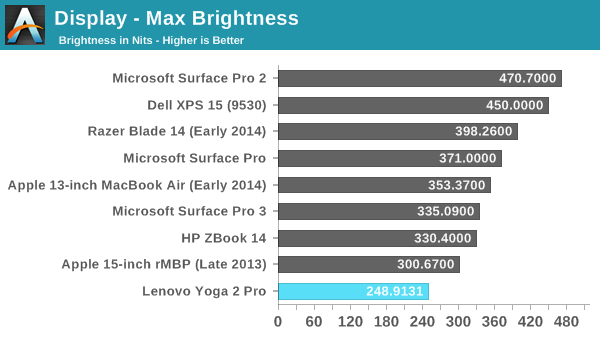
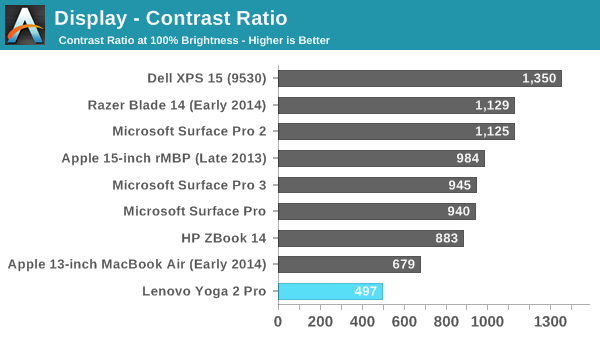
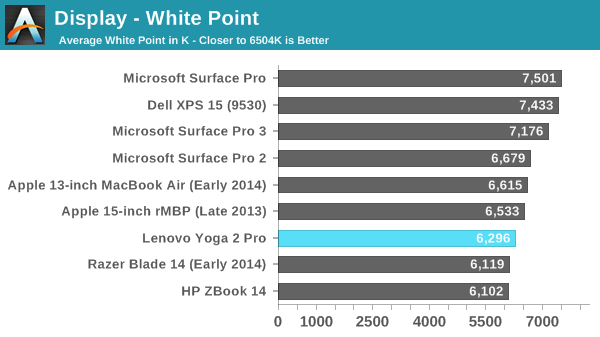
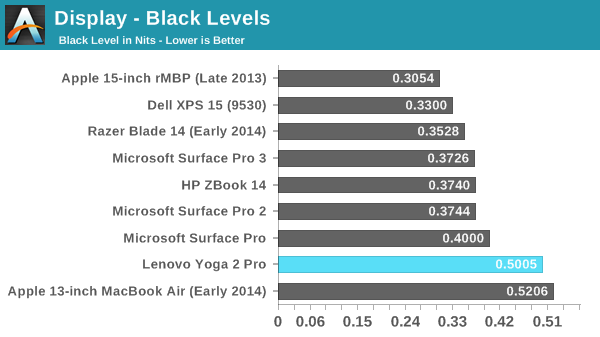
Contrast ratios aside, other elements of the display are pretty good for a consumer focused laptop. Out of the box, the greyscale DeltaE is an impressive 1.417. Blues are a bit low in the overall score, but only a bit.
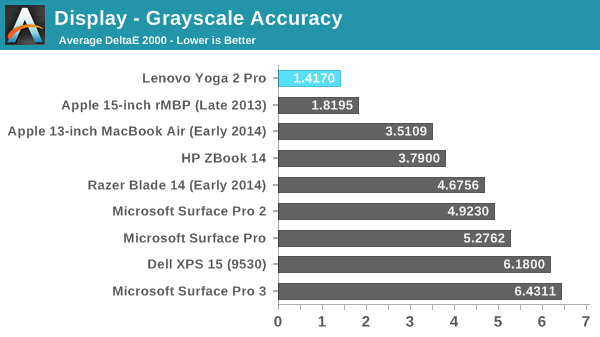
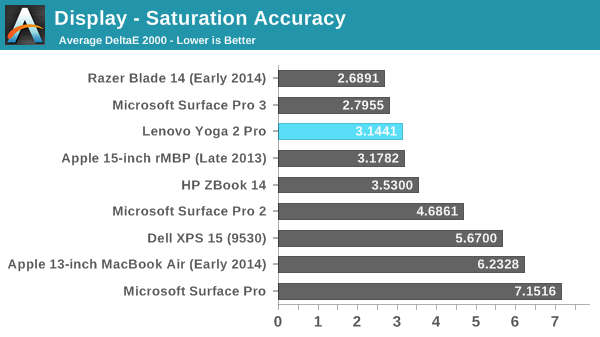
The uncalibrated saturation is also decent at 3.1441. There is definitely some drift, but it is not terrible. The yellows are spot on for saturation, which is a good sign after the firmware and software fixes to correct that. Cyan and Magenta are off, which is a theme going forward.
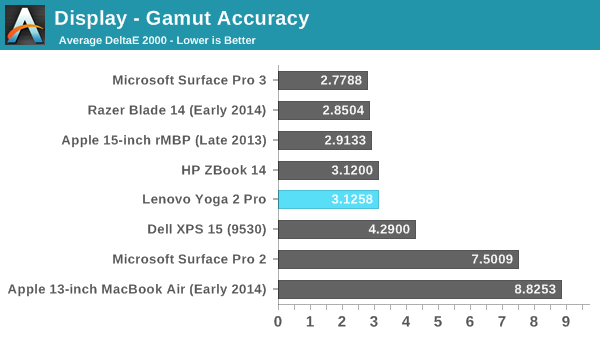
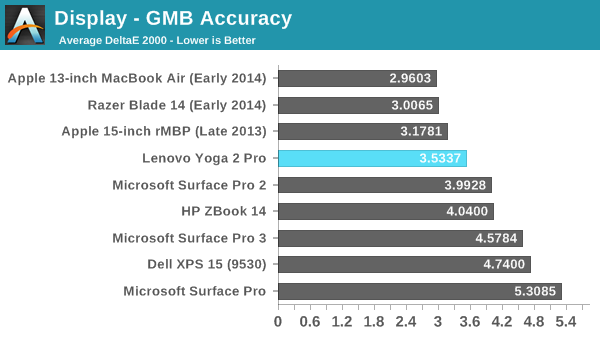
For the Gretag Macbeth colorchecker, we once again have a reasonable result of 3.5337. This device is not going to be suited for a professional image editor, but it is not really marketed as a professional device. We are looking for values under three, and the Yoga 2 Pro is close.
Calibrated image quality
Next up we will take a look at the display after it has been calibrated.
Once calibrated, the already great greyscale gets even better, with a DeltaE 2000 of 0.7834 and a white point of 6570, but that excellent result does not carry over to the rest of the display’s abilities. Cyan is again our biggest culprit, with it having a DeltaE of around 7 when the display is calibrated. This actually pulls the GMB score higher than the stock settings.
Display conclusion
Just looking at the device specifications, this should be a great display with such a high resolution. But the pentile nature of the screen can and does cause havoc with both blacks and colors. Unfortunately this display is just OK. If it was compared against most laptop panels of only a year or two ago, it would likely be a standout with both IPS and high resolution, but unfortunately it falls somewhat short. The color accuracy is not ridiculous (at least patched) but the contrast ratio really hurts, and as someone who really prefers black levels very low, it is very noticable how much light gets through on dark content. However to be fair, the redeeming quality of the display is the QHD+ resolution and to achieve that at the price point Lenovo wanted they chose to go with RGBW. It’s a compromise, but one that really does deliver on the crispness of text and images.


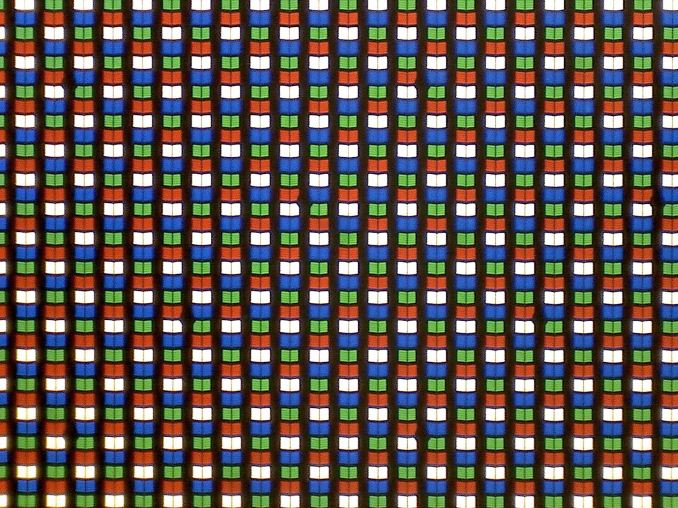
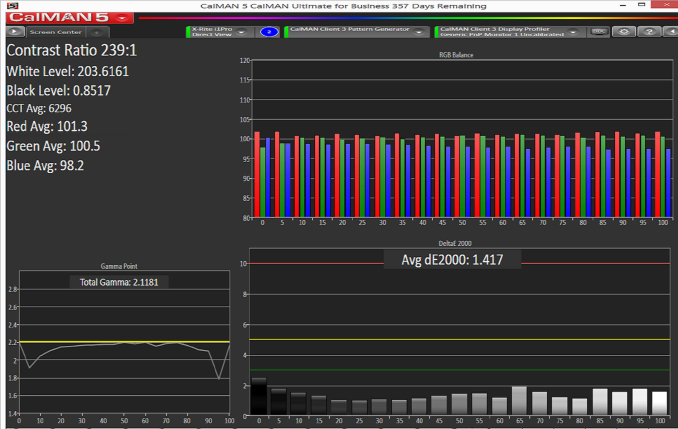





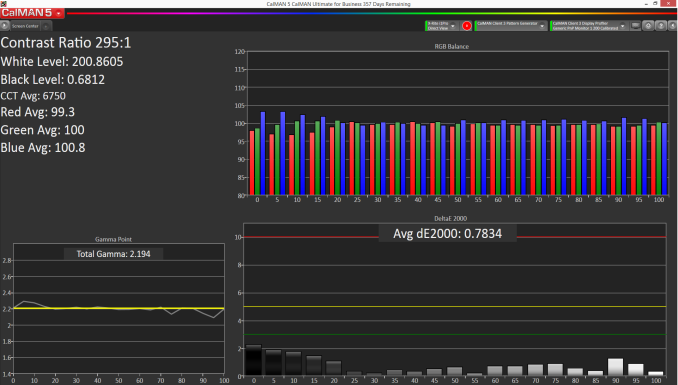











103 Comments
View All Comments
Brett Howse - Wednesday, July 30, 2014 - link
I did disable Auto Brightness in the power profiles. I tested in High Power mode, and Daily Mode (the default Lenovo power profile). I can retest in Balanced mode as well I'll let you know if there is a difference. What did you measure yours with?polacchini - Thursday, July 31, 2014 - link
Dear Brett, I used a retail i1 Display Pro, both with default software package and dispcalGUI. The rest of the measurements are quite like mine... Color checker dE ~3 and higher in some blue shades. I believe Lenovo released a BIOS patch which capped max brightness some time ago as some users reported. Mine was brought in May/14 and has latest BIOS installed. Could this be the issue?Brett Howse - Friday, August 1, 2014 - link
It's possible it is the BIOS. The maximum brightness I tested was with the i1 Display Pro as well. I'll test it a couple more times if and when I have a chance and see if I can get a better value.CaedenV - Wednesday, July 30, 2014 - link
#4, just a thought, but maybe your laptop is set up with secure boot? That could revert your boot order... you know, because booting from a Linux distro is so dangerous lol.ltcommanderdata - Wednesday, July 30, 2014 - link
Lenovo really ought to offer at least a BTO option for a CPU with the HD5000 to better match the 3200x1800 display.DigitalFreak - Wednesday, July 30, 2014 - link
I would have preferred a TPM chip so I could use bitlocker without a hassleBrett Howse - Wednesday, July 30, 2014 - link
Lenovo doesn't offer any BTO options on the Ideapad lines, at least in my region. I think this would be a good thing for them to implement but it would likely cost them more per machine.Narg - Wednesday, July 30, 2014 - link
The only real competitor to this is the MS Surface Pro 3 IMHO, though many others come close. And with this being cheaper than the Surface Pro 3, it would make a great unit for a lot of people.Impulses - Sunday, August 3, 2014 - link
Kind of different animals, Surface is tablet first and laptop second whereas this is the opposite... I still struggle to find a big usage case for either outside of college students and road warriors (granted that's two pretty big market slices).Bostonsfavson - Wednesday, July 30, 2014 - link
I purchased a Yoga 2 Pro from Best Buy (they only have one variant in stores now, I believe; an i7) last month and can confirm it has the AC 7260 card. Also, great write-up!